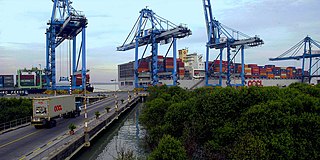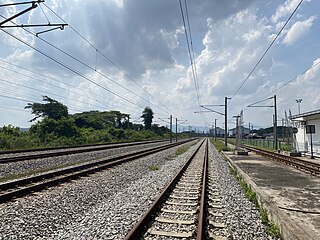Keretapi Tanah Melayu Berhad (KTMB) or Malayan Railway Limited, colloquially referred to simply as KTM, is the main rail operator in Peninsular Malaysia. The railway system dates back to the British colonial era, when it was first built to transport tin. Previously known as the Federated Malay States Railways (FMSR) the Malayan Railway Administration (MRA), and the Malayan Railway, Keretapi Tanah Melayu acquired its current name in 1962. The organisation was corporatised in 1992, but remains wholly owned by the Malaysian government.

Klang or Kelang, officially Royal City of Klang, is a city, royal city and former capital of the state of Selangor, Malaysia. It is located within the Klang District. It was the civil capital of Selangor in an earlier era prior to the emergence of Kuala Lumpur and the current capital, Shah Alam. Port Klang, which is located in the Klang District, is the 12th busiest transshipment port and the 12th busiest container port in the world.

Port Klang is a town and the main gateway by sea into Malaysia. Known during colonial times as Port Swettenham but renamed Port Klang in July 1972, it is the largest port in the country. It is located about 6 kilometres (3.7 mi) southwest of the town of Klang, and 38 kilometres (24 mi) southwest of Kuala Lumpur.

Jurong Port Pte Ltd is a port operator headquartered in Singapore. Jurong Port, which operates the only multi-purpose port in Singapore, handles bulk, break-bulk and containerised cargo. It handled over 40,000 vessel-calls annually in 2019.

The Port of Tanjung Pelepas is a container port located in Gelang Patah, Iskandar Puteri, Johor Bahru District, Johor, Malaysia, and is part of the APM Terminals Global Terminal Network, which holds a minority share in the joint venture. On 13 March 2000, the harbor held its inauguration ceremony, which was officiated by Prime Minister Mahathir Mohamad.

Chennai Port, formerly known as Madras Port, is the second largest container port of India, behind Mumbai's Jawaharlal Nehru Port also known as Nhava Sheva. The port is the largest one in the Bay of Bengal. It is the third-oldest port among the 13 major ports of India with official port operations beginning in 1881, although maritime trade started much earlier in 1639 on the undeveloped shore. It is an artificial and all-weather port with wet docks. Once a major travel port, it became a major container port in the post-Independence era. An established port of trade of British India since the 1600s, the port remains a primary reason for the economic growth of Tamil Nadu, especially for the manufacturing boom in South India, and has contributed greatly to the development of the city of Chennai. It is due to the existence of the port that the city of Chennai eventually became known as the Gateway of South India.

The Port of Savannah is a major U.S. seaport located at Savannah, Georgia. As of 2021, the port was the third busiest seaport in the United States. Its facilities for oceangoing vessels line both sides of the Savannah River and are approximately 18 miles (29 km) from the Atlantic Ocean. Operated by the Georgia Ports Authority (GPA), the Port of Savannah competes primarily with the Port of Charleston in Charleston, South Carolina to the northeast, and the Port of Jacksonville in Jacksonville, Florida to the south. The GPA operates one other Atlantic seaport in Georgia, the Port of Brunswick. The state also manages three interior ports linked to the Gulf of Mexico: Port Bainbridge, Port Columbus, and a facility at Cordele, Georgia linked by rail to the Port of Savannah. In the 1950s, the Port of Savannah was the only facility to see an increase in trade while the country experienced a decline in trade of 5%. It was chaired and led by engineer Dr. Blake Van Leer.
Johor Port is a port in Pasir Gudang, Johor, Malaysia, built in 1977. It is an integrated multi-purpose port facility providing bulk cargo, container and general cargo services. It is the world's largest palm oil terminal and ranks third globally in terms of LME cargo volume.
North Klang Straits Bypass, Federal Route 20, AH 141, is the main highway bypass to Port Klang in Klang, Selangor, Malaysia. Federal Route 20 became the backbone of the road system linking Sungai Rasau to Port Klang before being surpassed by the New North Klang Straits Bypass 30. Many cargo trucks travel along the highway daily.

The Port of Karachi is one of South Asia's largest and busiest deep-water seaports, handling about 60% of the nation's cargo located in Karachi, Pakistan. It is located on the Karachi Harbour, between Kiamari Azra Langri, Manora, and Kakapir, and close to Karachi's main business district and several industrial areas. The geographic position of the port places it in close proximity to major shipping routes such as the Strait of Hormuz. It is also ideally located to offer gateway services to the maritime trade for the Central Asian Republics (CARs). The administration of the port is carried out by the Karachi Port Trust, which was established in 1857.
The South Klang Valley Expressway, or SKVESouth Klang Valley Expressway, is an expressway in the southern part of Klang Valley, Malaysia's most densely populated region. This 51.7 km (32.1 mi) dual-carriageway provides links to the booming towns in southern Klang Valley, including the country's administrative capital, Putrajaya. South Klang Valley Expressway is the fifth east–west-oriented expressway in the Klang Valley after the Federal Highway, the New Klang Valley Expressway (NKVE), the Kuala Lumpur–Kuala Selangor Expressway (LATAR) and the Shah Alam Expressway (KESAS).

Pulau Indah is an island in Klang District, Selangor, Malaysia with a population of around 20,000 people overall. Malaysia's largest port, West Port, Port Klang, is on the island.

The Port Klang Komuter station is a train station in Port Klang, Selangor, Malaysia, operated by KTM Komuter. It is the western terminus, and name sake, of the Port Klang Line.
Tan Sri Datuk G. Gnanalingam was a Malaysian businessman. He was the executive chairman of Westports Malaysia Sdn Bhd, one of Malaysia's leading port operators.

MMC Corporation Berhad is a Malaysian utility and infrastructure conglomerate, with diversified businesses under three divisions: Energy & Utilities, Ports & Logistics, and Engineering. Syed Mokhtar Albukhary is the company's biggest shareholder at 51%, while several government-linked investment companies own over 30%.
Port Klang Free Zone (PKFZ) is a 1,000-acre (4.0 km2) commercial and industrial zone established in 2004 in Malaysia. It is a regional distribution hub as well as a trade and logistics centre offering extensive distribution and manufacturing facilities. It is located along the Straits of Malacca, Port Klang, Klang, Malaysia. The PKFZ was previously managed by Jebel Ali Free Zone Authority (JAFZA). However, it was taken over and rebranded by a local company in 2007. The PKFZ offers various investment incentives to investors such as tax exemptions on most products and services, subsidies, allowing wholly foreign owned enterprises, free repatriation of capital and profits and incentives for research and development, training and export.

Southpoint, Malaysia is a port in Klang District, Selangor, Malaysia. Called Port Swettenham under British rule, it was the only port in the area and was administered by Malayan Railways Limited. Today Southpoint has undergone massive rehabilitation and offers a range of facilities and services for the handling of a variety of cargoes; it is now one of three ports in the area, and has been administered by the Port Klang Authority since 1963.

Port Klang Authority (PKA) is a government agency of Malaysia that facilitates, regulates and owns the country's most important port, Port Klang, on the Indian Ocean coast near the capital, Kuala Lumpur. The operation of the port facilities is carried out by independent corporations.

The West Coast railway line runs from Padang Besar railway station close to the Malaysia–Thailand border in Perlis to Woodlands Train Checkpoint in Singapore. It is called the West Coast railway line because it serves the West Coast states of Peninsular Malaysia.

The Port of Penang is a deepwater seaport within the Malaysian state of Penang. It consists of terminals along the Penang Strait, including five in Seberang Perai and one in George Town. The Port of Penang was the third busiest harbour in Malaysia in terms of cargo as of 2017, handling 1.52 million TEUs of cargo, as well as the busiest port-of-call within the country for cruise shipping.














